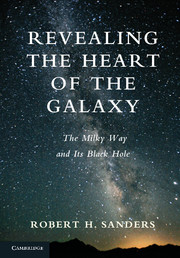Book contents
- Frontmatter
- Contents
- Acknowledgements
- 1 Introduction: The Luminous Pathway
- 2 The Discovery of the Milky Way Galaxy
- 3 The New Physics
- 4 Parting the Veil with Radio Astronomy
- 5 The Violent Universe
- 6 New Windows on the Galactic Center
- 7 The Milky Way as a Barred Spiral Galaxy
- 8 The Evolving View of Active Galactic Nuclei
- 9 The “Paradox of Youth”: Young Stars in the Galactic Center
- 10 Stellar Orbits in the Galactic Center, QED
- 11 Black Holes Here, Black Holes There…
- 12 Traces of Activity: Past, Present, and Future
- 13 After Words: Progress in Astronomy
- References
- Index
6 - New Windows on the Galactic Center
Published online by Cambridge University Press: 05 December 2013
- Frontmatter
- Contents
- Acknowledgements
- 1 Introduction: The Luminous Pathway
- 2 The Discovery of the Milky Way Galaxy
- 3 The New Physics
- 4 Parting the Veil with Radio Astronomy
- 5 The Violent Universe
- 6 New Windows on the Galactic Center
- 7 The Milky Way as a Barred Spiral Galaxy
- 8 The Evolving View of Active Galactic Nuclei
- 9 The “Paradox of Youth”: Young Stars in the Galactic Center
- 10 Stellar Orbits in the Galactic Center, QED
- 11 Black Holes Here, Black Holes There…
- 12 Traces of Activity: Past, Present, and Future
- 13 After Words: Progress in Astronomy
- References
- Index
Summary
The Near Infrared and the Distribution of Stars in the Galactic Center
At 26000 light years the center of the Milky Way Galaxy is the closest galactic nucleus. At that distance one light year corresponds to about 8 arc seconds, which is easily resolvable with large optical telescopes; in fact, such instruments can resolve one arc second, which would correspond to one and one-half light months at the distance to the Galactic Center. Even the Schwarzschild diameter of a four-million solar mass black hole would have an angular size of 20 micro-arc seconds (20 millionths of an arc second), which can be resolvable by VLBI (very long baseline interferometry) at a wavelength of 1 millimeter. So if one wishes to observe a galactic nucleus in fine detail, the center of the Milky Way is the place to look.
This was realized by Jan Oort, who in the 1970s became intensely interested in the Galactic Center and the processes that might be going on there. Oort was impressed by the number of gas features observed in the 21-cm line of neutral hydrogen in the general direction of the center that appeared to be expanding away from the center - features such as the 3-kiloparsec arm, seen in absorption at -53 km/s (motion toward the Sun and away from the center), and a less prominent feature apparently on the opposite side of the center but moving away at 135 km/s.
- Type
- Chapter
- Information
- Revealing the Heart of the GalaxyThe Milky Way and its Black Hole, pp. 69 - 82Publisher: Cambridge University PressPrint publication year: 2013



